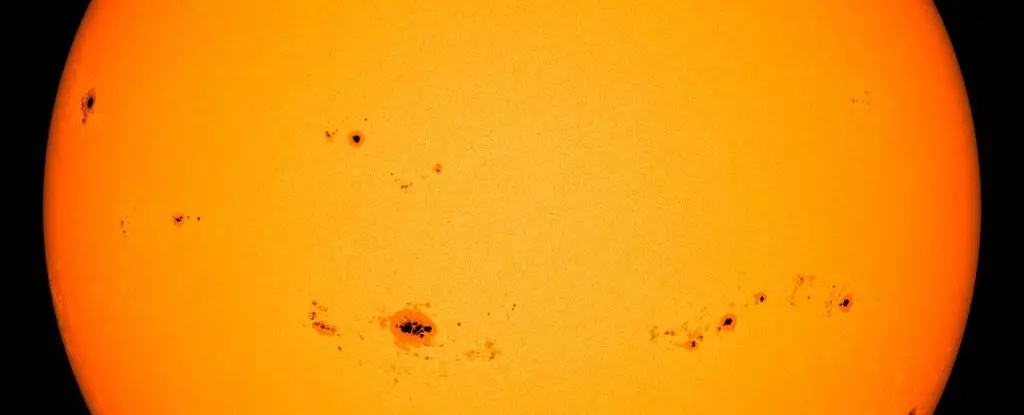The dynamics of the Sun, our nearest star, are currently captivating the attention of scientists and enthusiasts alike, as NASA, the National Oceanic and Atmospheric Administration (NOAA), and the Solar Cycle Prediction Panel have declared that we have officially entered the solar maximum phase. This phase marks the peak of an approximately 11-year solar cycle characterized by heightened activity on the Sun’s surface, including the formation of sunspots, intense solar flares, and massive coronal mass ejections. As these solar phenomena become more frequent, the implications for Earth and its inhabitants grow increasingly significant.
Solar scientist Elsayed Talaat explains that while we are in this pivotal phase, the exact timing of when solar activity will reach its highest point remains uncertain. Despite being in the solar maximum period, the month with peak solar activity may not be established for months or even years after we officially enter this phase. This uncertainty showcases the complexity of solar behavior and the difficulties involved in predicting solar activity.
Central to understanding solar cycles is the enigmatic nature of the forces at play within the Sun. Although these cycles have an average duration of 11 years, their lengths can vary significantly. The underlying processes that govern solar activity, including sunspot formation and solar flares, remain one of the unsolved puzzles in modern astrophysics. Michael Wheatland, a solar astrophysicist at the University of Sydney, emphasizes that comprehensive understanding of the solar dynamo—responsible for generating the magnetic fields associated with solar activity—continues to elude scientists.
Despite the unpredictability in solar cycle behavior, scientists have established key indicators that allow for ongoing monitoring of solar activity. The most visible manifestation is the presence of sunspots. These darker patches, resulting from concentrated magnetic fields that prevent the regular flow of hot plasma from the Sun’s interior, come and go throughout the solar cycle. During solar maximum, these spots multiply, marking a period of increased activity that can have profound effects on technology and atmospheric phenomena on Earth.
The Effects of Solar Activity on Earth
The repercussions of heightened solar activity ripple across space and deeply intertwine with life on Earth. Solar flares, which are sudden bursts of radiation, can lead to radio blackouts and disrupt communication systems. The more formidable coronal mass ejections, which involve massive eruptions of solar plasma and magnetic fields, can result in geomagnetic storms upon intersecting with Earth’s magnetic shield. These storms carry potential hazards for power grid stability, satellite functions, and navigation systems.
Nonetheless, there’s a silver lining. As solar particles interact with Earth’s upper atmosphere, they create stunning auroras—an otherworldly phenomenon that draws visitors and scientists alike to polar regions. The frequency of these magical light displays has surged in recent months, a testament to the vigor of our Sun during this cycle.
Interestingly, while this current solar cycle is exhibiting levels of activity that exceed initial forecasts, it is not the most extreme ever recorded. For context, the X9.0 flare that occurred on October 4 represents one of the most significant outputs of this cycle but is nestled within the top 20 strongest flares recorded to date. Comparison with historical flares reveals that while this solar maximum is robust, it does not approach the intensity of some past events.
The discrepancies between early predictions and actual observations present opportunities for further investigation. Some scientists had anticipated a stronger solar cycle with greater accuracy, raising essential questions about the efficacy of current models used to forecast solar behavior. Understanding these outcomes might refine our understanding of solar dynamics and enhance forecasting methods.
As we bask in the glow of our solar maximum, we are reminded of the complexities of our cosmic neighborhood. The current situation perfectly encapsulates the blend of awe and fear that comes with the study of celestial forces. As solar activity presents both challenges and beauty, it prompts a call to action for continued monitoring and research. Ongoing studies into solar cycles not only enhance our understanding of the Sun’s behavior but also prepare us for the potential impacts on Earth.
In closing, while we may face turbulent space weather ahead, these turbulent times also promise exciting breakthroughs within solar physics. Each observation and each flare adds to our collective knowledge and appreciation of the magnificent Sun that nourishes our planet. Strap in and remain curious; the story of our Sun is far from over.



Leave a Reply